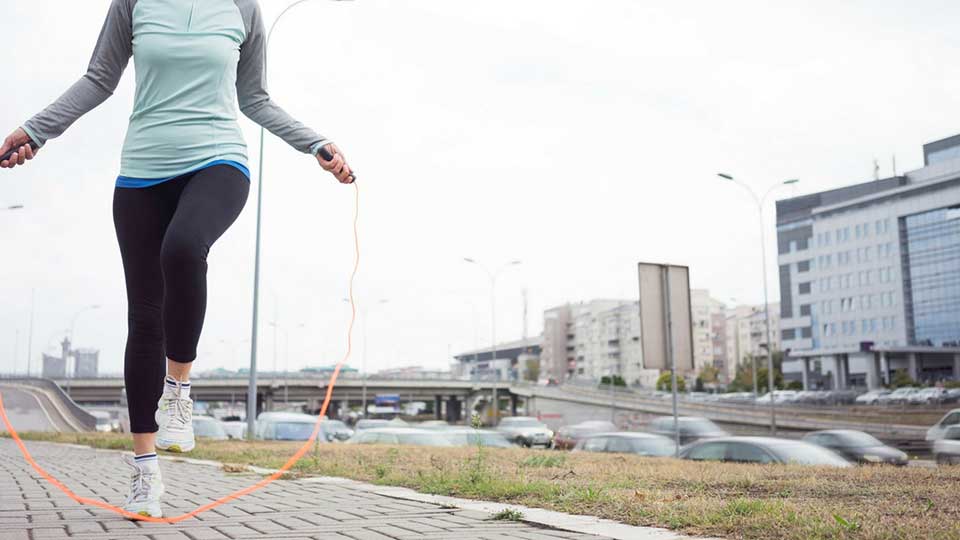Preventing Bone Loss and Rebuilding Bone with Exercise

Imagine having bones so fragile even a sneeze can lead to a painful fracture or break. For people living with severe osteoporosis, avoiding a situation like this is an everyday challenge. Fortunately, for many who are at risk for developing osteoporosis, preventive exercises can help keep bones in good shape. Mariah Wagner, who is a trainer at YMCA HEALTHY LIVING CENTER - INTEGRIS Health, shares her fitness tips to make sure your bones stay strong and healthy.
What is osteoporosis?
Osteoporosis is a disease that weakens the body’s bones, leading to fractures and breaks. There is no known cause for osteoporosis, but it typically happens with age. In a healthy body, bone is constantly being broken down and rebuilt. As the body ages, some gradual bone loss is expected because the process of rebuilding bone slows. This leads to decreased bone mass, making bones fragile and prone to breaking. In extreme cases of bone loss, osteoporosis is the result.
Symptoms
It’s unlikely that someone will feel symptoms in the early stages of osteoporosis. As the bone loss becomes more aggressive, loss of height and stooped posture can occur. Pain in the back is also tied to osteoporosis. Broken bones, especially in the hip, are also possible.
Who is at risk?
Several factors like family history, age, sex and body structure can increase a person’s chance of developing osteoporosis. Bone mass peaks between ages 25 and 30. After it peaks, bone loss is likely to increase slightly at first and then become more extreme with age. The risk for osteoporosis increases dramatically after age 50.
Women are more likely than men to develop osteoporosis. After menopause, women begin making less estrogen, which is an important hormone for the bone rebuilding process. The bone loss rate increases during and after menopause for several years.
Smoking and some medications can also lead to loss of bone mass.
Preventing bone loss and rebuilding bone with exercise
Life with osteoporosis isn’t easy, but the good news is that a combination of diet and exercise can help prevent bone loss and rebuild lost bone. A healthy, balanced diet full of adequate vitamin D and calcium is key, especially for women.
Weight-bearing exercises are also vital for osteoporosis prevention and bone rebuilding. "Weight-bearing" means moving against gravity while remaining upright and having your feet and legs support your body weight. "Weight-bearing exercises help encourage bone growth and help increase bone mass. These exercises place stress on the bone. The stress helps bone to rebuild," Wagner says.
The appeal of many weight-bearing exercises, like walking and stair climbing, is that they are easy to incorporate into everyday life and don’t necessarily require a gym. They can also be modified for intensity.
Wagner cautions it’s important to start slowly. If you have fractures in the spine because of osteoporosis, do not try activities in which you reach down, bend forward, make rapid twisting motions, or do any heavy lifting or anything else that increases the chances of a fall.
Do not do high-impact weight-bearing exercises if you have broken a bone due to osteoporosis, are at risk of breaking a bone, are frail, or fall easily.
Wagner recommends stress exercises that target areas of the body that are especially prone to bone-loss fragility, like the wrists, pelvis and hips. "It is important to incorporate a combination of exercises that place stress on different bones for a more overall prevention workout," she says. The following exercises can easily fit into a prevention lifestyle.
Good exercises for promoting bone health
Low-impact weight-bearing exercises can help prevent further bone loss.
- Brisk walking − A low-impact weight-bearing exercise that can be done virtually anywhere.
- Functional movements − Such as standing and rising up on your toes.
- Intermittent movements − Such as pushing a lawn mower, raking, digging, etc.
- Wrist curls − Simple wrist curls with small weights can help protect a vulnerable part of your body.
- Hip abductions − Leg-lifting hip abductions can be practiced right in your living room.
High-impact weight-bearing exercises can help rebuild lost bone.
- Climbing stairs − Walking up and down steps at a brisk pace provides both an aerobic workout and bone strengthening.
- Dancing
- Hiking
- Jogging
- Tennis or other racket sports
- Jumping rope − A study from 2015 showed that middle-aged women who did a series of jumping exercises twice a day for four months significantly increased the bone density in their hips.
For more information about high-impact exercise and healthy bones, see the website of the National Osteoporosis Foundation.
Posture exercises help prevent the signature stoop associated with osteoporosis.
- Shoulder squeezes − Wagner recommends performing these by gently pushing shoulder blades together and holding for five to 10 seconds.
Building healthy lives (and bones) at INTEGRIS
Start your preventive health journey with INTEGRIS. Check out the fitness classes available at the YMCA HEALTHY LIVING CENTER – INTEGRIS.
For those suffering from osteoporosis, a physical rehabilitation program can be vital to a full recovery. The focus of rehab is to decrease pain, help prevent fractures and minimize further bone loss. For more information, please visit the INTEGRIS Jim Thorpe Rehabilitation website.



